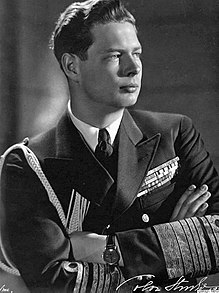
Back Michael I Rumǣnie Cyning ANG ميخائيل ملك رومانيا Arabic ميخائيل ملك رومانيا ARZ Miguel I de Rumanía AST I Mixay Azerbaijani بیرینجی میخاییل (رومانی) AZB Михай I Bashkir Міхай I Byelorussian Михай I Bulgarian Miquel I de Romania Catalan
| Michael I Mihai I | |
|---|---|
 Michael I in 1947 | |
| King of Romania | |
| First reign | 20 July 1927 – 8 June 1930 |
| Predecessor | Ferdinand I |
| Successor | Carol II |
| Regents | See list
|
| Second reign | 6 September 1940 – 30 December 1947 |
| Predecessor | Carol II |
| Successor | Monarchy abolished. Constantin Ion Parhon as President of the Provisional Presidium of the Republic |
| Coronation | 6 September 1940 |
| Born | 25 October 1921 Peleș Castle, Sinaia, Kingdom of Romania |
| Died | 5 December 2017 (aged 96) Aubonne, Vaud, Switzerland |
| Burial | 16 December 2017 Royal Cathedral, Curtea de Argeș Monastery, Curtea de Argeș, Romania |
| Spouse | |
| Issue | |
| House |
|
| Father | Carol II of Romania |
| Mother | Helen of Greece and Denmark |
| Religion | Romanian Orthodox |
| Signature | |
Michael I (Romanian: Mihai I [miˈhaj]; 25 October 1921 – 5 December 2017) was the last king of Romania, reigning from 20 July 1927 to 8 June 1930 and again from 6 September 1940 until his forced abdication on 30 December 1947.
Shortly after Michael's birth, his father, Crown Prince Carol, had become involved in a controversial relationship with Magda Lupescu. In 1925, Carol was pressured to renounce his rights (in favour of his son Michael) to the throne and moved to Paris in exile with Lupescu. In 1927, following the death of his grandfather Ferdinand I, Michael ascended the throne at age five, the youngest crowned head in Europe.[1] As Michael was still a minor, a regency council was instituted, composed of his uncle Prince Nicolas, Patriarch Miron Cristea and Chief Justice Gheorghe Buzdugan. The council proved to be ineffective and, in 1930, Carol returned to Romania and replaced his son as monarch, reigning as Carol II. As a result, Michael returned to being heir apparent to the throne and was given the additional title of Grand Voievod of Alba-Iulia.
Carol II was forced to abdicate in 1940, and Michael once again became king.[1] Under the government led by the military dictator Ion Antonescu, Romania became aligned with Nazi Germany. In 1944, Michael participated in a coup against Antonescu, appointed Constantin Sănătescu as his replacement, and subsequently declared an alliance with the Allies.[1] In March 1945, political pressures forced Michael to appoint a pro-Soviet government headed by Petru Groza. From August 1945 to January 1946, Michael went on a "royal strike" and unsuccessfully tried to oppose Groza's communist-controlled government by refusing to sign and endorse its decrees. In November 1947, Michael attended the wedding of his cousins, the future Queen Elizabeth II of the United Kingdom and Prince Philip of Greece and Denmark in London. Shortly thereafter, on the morning of 30 December 1947, Groza met with Michael and compelled him to abdicate, while the monarchy was abolished. Michael was forced into exile, his properties confiscated, and his citizenship stripped. In 1948, he married Princess Anne of Bourbon-Parma, with whom he had five daughters.[1] The couple eventually settled in Switzerland.
Nicolae Ceaușescu's communist dictatorship was overthrown in 1989 and the following year Michael attempted to return to Romania, only to be arrested and forced to leave upon arrival. In 1992, Michael was allowed to visit Romania for Easter, where he was greeted by huge crowds;[1] a speech he gave from his hotel window drew an estimated one million people to Bucharest. Alarmed by Michael's popularity, the post-communist government of Ion Iliescu refused to allow him any further visits. In 1997, after Iliescu's defeat by Emil Constantinescu in the presidential election of the previous year, Michael's citizenship was restored and he was allowed to visit Romania again. Several confiscated properties, such as Peleș Castle and Săvârșin Castle, were eventually returned to his family.
© MMXXIII Rich X Search. We shall prevail. All rights reserved. Rich X Search